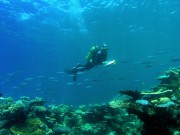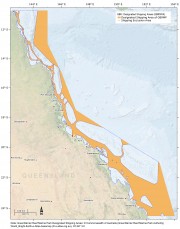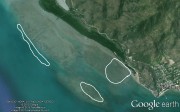Recent datasets
This project developed a set of high quality GIS datasets of the emergent and shallow marine features (reef boundaries, reef tops, islands, and cays) of the Coral Sea Marine Park (CSMP). The goal of this mapping was to improve the precision and spatial detail of existing reef maps.

This dataset describes the areas of research activities for the 38 National Environmental Research Program Tropical Ecosystem (NERP TE) Hub projects. It represents the areas that have field work being conducted, where measurements have been taken and where modelling or analysis is being done.
It consists of three master shapefiles (points, lines and polygons) that capture the regions that are being studied by all these projects. These master shapefiles are also made available split by project.
This project will investigate how coral communities along the Great Barrier Reef have historically responded to acute (e.g. cyclones) and chronic (e.g. water quality) disturbances using pioneering high-precision geological dating and palaeoecological techniques, combined with high-resolution geochemical analysis of coral records.
This project will determine high resolution chronological records on different time scales over the past 1-2 millennia of parameters such as:
1. Sea-level based on high-precision dating and elevation survey of well-preserved microatolls;
The project will determine the status of threatened marine (green, hawksbill and flatback) turtles and dugongs in the Torres Strait and threats to these populations. It also will investigate links between different populations of dugongs and turtles in terms of movement and habitat use. They will also assess the abundance of dugongs in the Torres Strait using aerial surveys.
Working in conjunction with the Torres Strait Regional Authorities (TSRA) Land and Sea Unit and the TSRA Community Ranger program this project will:
Pesticides, and particularly herbicides from agricultural sources, have been detected in nearshore sites of the Great Barrier Reef (GBR) all year round. The actual impact from these concentrations of herbicides is under debate and information on cumulative impacts is required. To address this, a series of experiments will examine how plants and corals are affected by herbicides in the water in conjunction with other stressors such as temperature, low salinity and low light. An important source of herbicides in coastal waters is flood plumes from river runoff.
This project will determine the movement and habitat use of large predatory fishes such as sharks and coral trout in reef and coastal environments of the Great Barrier Reef. This project will employ acoustic monitoring technology in a series of inshore and offshore environments including coastal bays, inshore reefs and offshore reefs to monitor the presence and movements of predator species (elasmobranchs and teleosts).

The rezoning of the Great Barrier Reef Marine Park (GBRMP) in 2004 increased the number and extent of ‘no-take’ areas within the Park. This project surveys pairs of reefs, one in a ‘no-take’ or green zone and the other a similar reef where fishing is allowed (blue zone), in five regions of the GBRMP. Green and blue zones will be surveyed for the abundance and size of fishery species, particularly coral trout, as well as wider effects on coral reef communities. The results of reef surveys will be used to:

This project is providing a direct assessment of the ecological effects of multiple-use zoning on inshore reefs of the GBRMP. Underwater visual census (UVC) monitoring of fish and benthic communities is being carried out at 50 no-take marine reserve (green zone) sites and at 50 sites that have remained open to fishing within the Palm, Magnetic, Whitsunday and Keppel Island groups. Long-term monitoring surveys are providing information on:
1. The effects of no-take marine reserves on populations of both species that are fished and other non-fished species.

This project uses genetic parentage analysis, biophysical modelling and information on coral trout larval behaviour to determine patterns of recruitment of coral trout larvae within and among inshore and offshore reefs in the southern Great Barrier Reef. The overall goal of this project will be to assess larval dispersal patterns, demographic connectivity and levels of recruitment subsidies from green zones at a regional scale. Tasks include:

There are 10 major trading ports along the Great Barrier Reef coast. The waters of most of these ports are within the Great Barrier Reef Region, but not within the Great Barrier Reef Marine Park.
In recognition of the outstanding values of the Great Barrier Reef, there are stringent management arrangements for commercial shipping in the waters of the Great Barrier Reef, which is designated a Particularly Sensitive Sea Area by the International Maritime Organisation. Shipping traffic is confined to Designated Shipping Areas in the Great Barrier Reef Region.

This dataset consists of site means of the density of derelict fishing line, the percent cover of major benthic categories on fringing coral reefs of the Keppel, Whitsunday and Palm Island groups, and the accumulation rate of fishing line at ten sites in the Palm Islands between 2007 and 2009.

This dataset contains Active Licenses, Effort days, Harvest Weight and GVP for the Queensland commercial harvest, line, net, pot and trawl fisheries. The data is provided on a 30 min grid for locations where there are more than 5 licensed operators.
Commercial fishers and charter fishers are required by law to complete daily logbooks. Commercial fishing logbooks are used to record: overall catch, time spent fishing, location where catch was taken and fishing equipment used. This data is then managed by the Department of Agriculture, Fisheries and Forestry (DAFF).

The data consists of ten minute readings of above water meteorological parameters (wind speed, wind direction, barometric pressure, air temperature and humidity) from a Vaisala WTX520 instrument, above water light as Photosynthetically Active Radiation (PAR) from a Li-COR Li-192 sensor and below water parameters including Salinity using a Sea-Bird SBE37 CTD and temperature via a Sea-Bird SBE39 temperature sensor. Data are from two sites, one at Madge Reef near Thursday Island (-10.595125° | 142.220572°) and one at Masig (Yorke) Island (-9.758293° | 143.397584°).

This dataset shows the spatial distribution of the number of visitors to the Great Barrier Reef Marine Park based on visitation rates collected from the Environmental Management Charge (EMC) managed by GBRMPA. The spatial information has been quantised into a 0.1 degree grid size.
This data only represents visitors to the Great Barrier Reef who used commercial tourist operations. Data is collected and updated quarterly following receipt of Environmental Management Charge returns from tourism operators. This dataset is a set of annual snapshots of this monthly data.

The Reef Check Australia monitoring program acts as an early warning system for coral community health. Annual surveys provide long-term data that can reveal patterns over time. Trained community volunteers collect quantitative data on the Great Barrier Reef and in the Southeast Queensland coral habitats. Data include substrate percent cover, abundance of key invertebrate species and target fish species. Data on natural and anthropogenic impacts on coral community health are also recorded.

* Catch data from fisheries independent sampling in inshore habitats (inshore reefs, intertidal flats/foreshores, seagrasses and mangroves) of the GBRWHA (Cleveland Bay and Halifax Bay) using bottom-set multihook research lines (long lines) geared to capturing sharks
* Data includes catch and effort data for all species captured.
* Data includes biological data of captured blacktip reef sharks - BTS (Carcharhinus melanopterus).

Sharks play an important role in marine ecosystems but are facing increasing pressure from fishing and other anthropogenic factors. Along the Queensland coast inshore waters play an important role as nursery areas for sharks. However, the same inshore waters are also most prone to fisheries exploitation and effects of freshwater discharge from coastal streams and rivers. This project will examine the importance of different types of inshore habitat (protected bay vs.

Overall the key objectives of this program are to:
1. Identify and map the principal foraging locations for shearwaters and boobies breeding at the most important colonies of the GBR, both within and between breeding seasons, using a combination of different Geolocation, GPS and Satellite PTT data loggers;
2. Obtain detailed information on the biophysical oceanographic characteristics of these foraging habitats in both the GBR and Coral Sea regions using a range of biophysical parameters derived from satellite and in situ data;

This is data associated with MTSRF Task 4.8.4s, a MTSRF supported PhD project titled /Biology and ecology of the blacktip reef shark/. As part of this project, basic water quality data were collected during shark tagging trips at the study site - Cockle Bay Reef at Magnetic Island. The meta data regarding these shark catch and tagging trips are recorded in a separate data file.
Basic water quality of Cockle Bay was measured at weekly to monthly intervals with handheld instruments - a YSI water quality meter (temp, salinity, condutivity, dissolved oxygen), and secchi disk depth.

The purpose of this study was to quantify patterns in skeletal density, linear extension and calcification throughout the GBR based on the AIMS Coral Core Archive of 328 colonies of massive Porites from 69 reefs. Annual data for the three growth parameters, skeletal density, annual extension, and calcification rate (the product of skeletal density and annual extension) were obtained from each colony using standard x-ray and gamma densitometry techniques.



